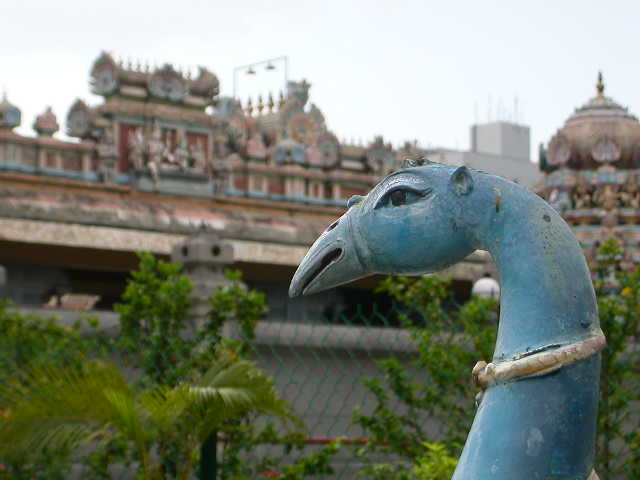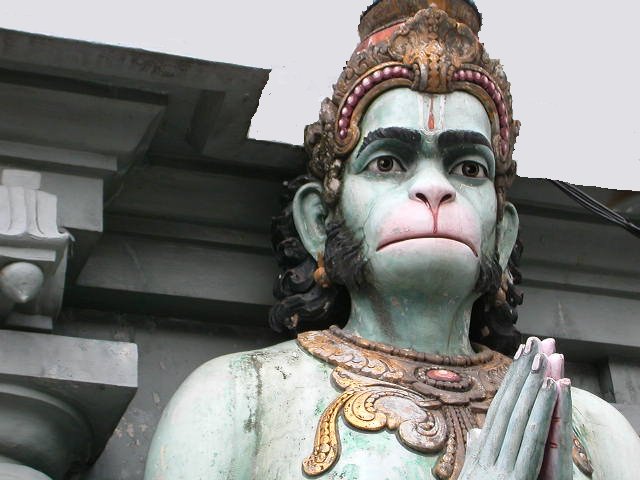» Foreign Doctors in Malaysia » Information for Indians Hoping to Work in KL » Information Technology Jobs in Malaysia » Jobs for Africans in Malaysia » Jobs for Indians in Singapore » Make Friends with Singapore Girls » Medical Jobs in Malaysia 
Pictures of Little India Kuala Lumpur Malaysia Maps Interactive photographic map of the entire world!
|
India has entered the Era of Gloablization in a big way and from Tokyo to the US and Canada and Australia, Indians can be found looking for jobs and pitching their business ideas. Singapore has emerged as one of the favorite destinations for Indian jobseekers, and a relationship has developed which benefits both partners.
This is from the Financial Express: SINGAPORE ROLLS OUT RED CARPET FOR INDIAN TECHIES' IDEAS (October 17 2005): Unable to take advantage of the growing labour-intensive business process outsourcing (BPO) services market like India and China, Singapore has started providing incubator services to individuals with ideas in a big way. Singapore minister for manpower and second minister for defence NG Egn Hen says, E½gIn Singapore, one can test one's idea. The successful experiments can subsequently be replicated on a large scale to feed bigger markets. "The government, according to the minister, wants entrepreneurs in the knowledge sector to use the facilities provided in the city state as a launching pad in pursuance of bigger dreams. "What is significant about hosts of industrial parks and incubator centres is that one can spot significant number of Indians, especially the information technology experts, pursuing their ideas in diverse fields as information technology, embedded software, biotechnology, engineering services, industrial design, etc. The Indian entrepreneurs find it easier to work in Singapore which houses 1,526 Indian firms. These include large Indian corporations, technology enterprises and start-ups. The prominent Indian companies which have significant presence in Singapore include TCS, Satyam, Bilcare, Dr Rao Holdings, VSNL and NIIT. "The latest addition to the series of technology parks to help start-ups is Fusionpolis which is expected to be completed by the second half of 2007. Fusionpolis, according to Mr Philip Su, assistance CEO, JTC Corporation, "is the second major development in the One-North research and innovation hub after Biopolis." The JTC, it may be mentioned, has developed 7,000 hectares of industrial land and over 4 million square meters of ready-built factory space. Currently, the corporation has under its management 39 industrial and specialised parks which include four water fab parks and an advanced display park, two business parks, a chemicals hub, a biomedical park and logistic hubs for air, chemical and general warehousing industries. Together, they house about 7,000 local and foreign companies. "According to Mr Philip, the twin-tower Fusionpolis, which is being developed at a cost of S$ 560 million, will be the first integrated work-live-play-learn development in the One-north, SingaporeE½fs icon of the knowledge economy..." Bridge Singapore reported: " Without pausing for thought Mohan Aiyer, 40, gave a resounding "yes" when asked whether he would be interested in doing an executive MBA programme with the Indian Institute of Management-Bangalore (IIM-B) when it opens an offshore Asian campus in Singapore later this year. "Of course, I'll do the course. They're number one and have been long established. Getting an IIM education would be a very good thing for anybody, primarily because the people who come out of these institutions go on to become role models globally," says the Indian-born entrepreneur, who has been living and working in Singapore for the past seven years.
Now IIM-B - the business school in India's Silicon Valley of Bangalore - hopes to export its strength in business strategy and finance by offering an online EMBA programme, targeted for November or December, at its Singapore campus. The initiative will be hosted at Bhavan's Indian International School, with the institute sharing its lecture halls, seminar and conference rooms, library and computer centre. At the moment, there are plans to offer only a virtual, part-time EMBA course, which can be completed over a year and a half. However, more courses may be added as the school establishes its presence in the city-state. "The EMBA course modules would be taught online, with nearly all the faculty members, in terms of teaching staff, working out of our Indian campus," says Prakash Apte, director of IIM-Bangalore, which counts the UK engineering company BAE among its long-standing clients for executive education. "But we're also looking at hiring locally-based faculty members depending on demand," he adds. Admission procedure, course content and evaluation are the same as those of IIM-Bangalore. However, in terms of credit equivalence, the course is structured to lead to an EMBA certification, rather than a full degree. Mr Apte says this is because the course focus is on broadening the outlook and strengthening the skills of practising ĆĀmanagers. This is achieved by discussing the latest developments in management thinking and their applicability in the Indian and global context. Participants also obtain valuable insights from extensive online interaction with their counterparts from other organisations. "Even though it may lead to just a certification, I strongly believe there would be demand for it given our brand equity," says Mr Apte. "In any sense, the certification would be of very high value since the quality of the education will match the high standards of the teaching at the institute." One of the notable features of an IIM education is the rigour of its teaching methods and processes. For the institute, one way of building on these strengths has been to widen its mandate with the launch of international student exchange programmes. IIM-B runs exchange programmes with 20 global centres. The school says every year nearly 25 per cent of its graduates are headhunted or poached by multiĆĀnationals and offered sky-high salaries. "The teaching you get there [at IIM] is value for money," says Mr Aiyer. "The rationale behind the education system is not money-making. For them it's not about running a profitable organisation, but rather the aim is to create intellectuals. Therefore, the teaching staff is very dedicated. The pedagogy and curriculum are comparable to the best globally, while the fee is at a fraction." As an overseas Indian national, Mr Aiyer fits the profile of the type of candidate the institute hopes to attract for its first EMBA. The initial enrolment target for this year is about 40 to 50 students. IIM-B officials say that although there is growing demand from south-east and north-east Asia for Indian education because of the alluring status of IIMs, Singapore was chosen primarily for having a large Indian population. "Although we're reaching out to the entire region, a large proportion of the students are likely to come from the Indians living and working around the region," says Mr Apte. He adds: "Singapore is an excellent market; we are familiar with the business environment and the industry. Our MBA students are continuously engaged in exchange projects there. But more than that, there's a sizeable overseas Indian community working in Singapore who know us and our value." While he would not comment on the cost of the EMBA, saying that the committee is still ironing out the pricing strategy, Mr Apte did say the tuition would be "priced competitively and is not going to be very high" when compared with other foreign institutions in higher business education. IIM-B's biggest competition in Singapore will probably come from Insead and the Chicago Graduate School of Business. Both have well-established campuses in the city-state, offering full-time and part-time MBA and EMBA courses. Insead charges about $108,000 for its EMBA, while the same course at Chicago costs about $103,000. The standard fee for a two-year MBA graduate programme at any of the IIM schools in India is about $7,500, which administrators say is about half the actual cost incurred by the college. IIMs make up most of the difference with revenues from executive training programmes and government subsidies. Although the regional market is large enough to accommodate many leading players, IIM-B's entry into Singapore is likely to up the ante for Insead and Chicago. While the brand equity of IIM-B is strong and its reputation precedes it, the key challenge would be positioning itself distinctly from its heavyweight rivals, says Mr Apte. "Of course, we would be seen as some degree of threat," he says. "If you look at the global environment now, India is fast becoming an economic powerhouse. There is a great interest in the knowledge of the Indian economy, in Indian companies and the peculiarities of the Indian market. And this is what we can provide better than ĆĀChicago or Insead. Fundamentally, this is where our strong value-proposition lies." Says Hindu On Net: "Jobbing for Work If you have been offered a job in Singapore, try and make sure your housing needs are taken care of by your employer. They may need to shell out anything from S$ 4-6,000. It is possible to get a modest flat at a Housing Board Colony for S$1500, but the neighbourhood may not fit in with your lifestyle. The company generally picks up electricity and water bills. If you come from one of the hot dry places in the country, be sure that the air conditioning is working well in your flat, as you will need it if you need sleep and rest to live! If you end up paying for yourself then budget for S$600 per month! Make certain your employer gives you full medical coverage and makes an allowance for transport. "You can't drive too far in Singapore without falling off the side of the island! As its only 22miles across, the Singapore government likes to give residents the feeling that the place is as large as a normal country. To do this they have arranged a series of one-way roads that necessitates a drive of about 30 miles to go to your neighbour's house for dinner! Parts of town are no drive areas for cars with less than four people inside unless you pay for a special permit. Parking cost the earth so its better not to buy a car. In fact it's the intention of the government to keep the numbers of vehicles down! " As Wikipedia reports: "Following Singapore independence in 1965, migration from India and other countries dwindled, and the Singapore population gradually acquired a more settled character. However, in the 1980s, a significant number of Indian Singaporeans began to migrate to Australia and other English-speaking developed countries. This was part of a minor brain drain from Singapore. Most emigrating families were middle class but culturally marginalised English-speaking minorities like the Peranakans, Eurasians, and gays. "The loss of more successful Indian families in the 1980s has been somewhat balanced by the arrival of highly qualified professionals from India since the 1990s. From the 1990s, Singapore's policy has been actively to attract highly skilled migrants from around the world and this has produced a fairly large expatriate Indian community of well-educated and wealthy professional and business people. It remains to be seen how permanent this migration is. Most have retained their Indian citizenship, although some have been granted Permanent Residence status. Interaction between the local and expatriate Indian community remains ambivalent rather than easy and natural. "Transient foreign workers who come to work in Singapore on short-stay work permits (two years validity, renewable) as unskilled or semi-skilled workers working in the as domestic workers and construction workers form a third Indian community. There is little interaction between this group and either the expatiate or local Indian communities."
Skilled Indians Shop for Jobs in Singapore>: By Ishani Duttagupta, The Economic Times.
Doctor Jobs: http://www.doctorjob.com.my/.
Expatriates -- Malaysia: http://expat3.securesites.net/classifieds/mly/.
GetAFreelancer: http://www.getafreelancer.com/.
Gulliver Resort Jobs: http://www.mygulliver.com/malaysia/.
Intel Malaysia: http://www.intel.com/jobs/malaysia/.
JobsDB: http://www.jobsdb.com/MY/EN/V6HTML/JobSeeker/jobalert/jobalert_e.htm.
Job Street: http://my.jobstreet.com/default.htm.
Learn 4 Good: http://www.learn4good.com/jobs/language/english/list/country/malaysia/.
Monster India: http://www.monsterindia.com/.
Naukri: http://www.naukri.com/.
Solo Gig: http://www.sologig.com/.
Tip Top Jobs: http://my.tiptopjob.com/.
s i n g a p o r e + i n d i a n s Indians in Singapore - defined as residents of South Asian paternal ancestry - form about 9% of the national population. While they are the smallest of the city-stateās three main 'races', among cities, Singapore has the one of the world's largest overseas Indian populations. Indian settlement on the island began with British rule in 1819. As a result of migration patterns, Singapore Indians are linguistically and religiously diverse, albeit with small majorities of Tamils and Hindus. Like the culture of the Chinese and Malays, Indian culture has endured yet evolved in response to local conditions over almost 200 years, becoming distinct from its cultural homelands. Indian elements are also diffused within a shared Singaporean culture. Singaporeās Indian population is notable for its class stratification, with disproportionately large elite and lower income groups. Although stratification has long existed in the Indian community, it has grown more visible since the 1990s with an influx of professionals from India. As a result, Indians now enjoy higher monthly average incomes, and are much more likely to hold a university degree, than the Chinese or Malays. However, the success of recently arrived Indian expatriates also masks the socio-economic problems faced by some longer-settled Indian Singapore citizens. Prominent Indian individuals have always made a mark in Singapore as leaders of various fields in national life. At the same time, Indians are collectively well represented, and often over-represented, in areas such as politics, education, diplomacy and the law. "'There were around 270 of us, and we have already got the signatures of 178, and we'll get the rest by Monday,' said Dilip, an IT professional, who presented a petition to the Indian High Commission on behalf of all those detained after being released on Sunday night. "A Malaysian police officer had earlier told PTI that some 164 Indians had been picked up during a raid on one building adding they were released following the intervention of the Indian High Commission and proof that they had valid visas. "Some showed they were working for companies registered in Malaysia's Multi-media Super Corridor, the Information Technology project zone running from Kuala Lumpur to the new development of Cyberjaya, some 45 minutes' drive away, he said. "'This has been a black day for all of us,' Indian High Commissioner Veena Sikri said addressing the detainees after their release. ""We have taken the matter to the highest authority, and we will get to the bottom of the issue.' "Police initially denied Indian officials access to the detained Indian nationals, but later relented. "Several Indians taken into custody showed PTI their passports, pointing out that their visas had been scratched. "A Malaysian immigration official, who verified the defaced visas, said the individuals and their employers would have to apply to his department for a fresh visa. "The detainees recounted how police burst into their homes and herded them to a nearby police station, from where some were taken to jail. "'We were handcuffed and made to kneel or sit in the police station car park, some of us were slapped and kicked,' said Nagaraju Cheekoti, an IT professional working for WWI Malaysia. "Some said they were ordered to do sit-ups, while others said they were stripped to their underwear, slapped and kicked inside the station. Police confiscated their cell phones and refused them access to telephones. "Police officials at the Brickfields station refused to speak to PTI. "'We don't want to stay in this country if we are treated like this. We have come here at the invitation of Malaysian companies,' said one of the detainees to a chorus of approval from other detainees. 'We don't feel safe,' he said..." How is life like for the resident Indians of Malaysia: This is from the Tamil Nation homepage: "Large scale migration of Indians from the sub continent to Malaya followed the extension of British formal rule to the west coast Malay states in the 1870s. As early as 1901 the Indian population in the Straits Settlements and the Federated Malay States was approximately 120,000, and by 1947 it had grown to almost 600,000 for Malaya and Singapore.' At the time of Independence in 1957 it stood at a little over 820,000. In this last year Indians accounted for approximately 11 per cent of the total population of Malaya and Singapore. "The overwhelming majority of migrants from India were Tamil speakers from the south of the sub continent. In 1947 they represented approximately 77 per cent of the total Indian population in Malaya and Singapore. Other South Indians, mainly Malayalee and Telegus, formed a further 14 per cent in 1947, and the remainder of the Indian community was accounted for by North Indians, principally Punjabis, Bengalis, Gujeratis, and Sindhis. "These ethnic divisions corresponded closely to occupational specialisation. For example the South Indian Tamils were predominantly labourers, the majority being employed on rubber estates, though a significant minority worked in Government public works departments. The Telegus were also mainly labourers on the estates, whilst the Malayalee community was divided into those who occupied relatively more skilled labouring positions on the estates and those who were white collar workers or professionals. The North Indians, with the exception of the Sikhs, were mainly merchants and businessmen. For example, the Gujeratis and Sindhis owned some of the most important textile firms in Malaya and Singapore. The Sikhs were either in the police or employed as watchmen. "There were, in addition, three further ethnic and religious groups whose political and economic importance in Malaya far exceeded their numerical strength. Two were important business communities the Chettiars, a money lending caste from Madras, and the South Indian Muslims (Moplahs and Marakkayars) who were mainly wholesalers. The third group were the Ceylonese Tamils who were employed principally in the lower levels of the Civil Service and in the professions. "The close correspondence between the ethnic and occupational divisions of the Indian community was inevitably reflected in the community's geographical distribution in Malaya. The South Indian Tamils were concentrated mainly in Perak, Selangor, and Negri Sembilan, on the rubber estates and railways, though a significant proportion found employment on the docks in Penang and Singapore The Telegus were mainly on the rubber estates of Lower Perak and parts of Selangor, while the Malayalees were located predominantly in Lower Perak, Kuala Lumpur, parts of Negri Sembilan, and Johore Bahru. The business communities, the Gujeratis, Sindhis, Chettiars, and South Indian Muslims, were concentrated in the urban areas, principally Kuala Lumpur, Penang, Ipoh, and Singapore. The Ceylon Tamils were also mainly an urban community, though some were found in rural areas working as subordinate staff on the estates...." The Tamil Nation goes on to record: "Despite the fact that the Indians constitute about 8% of the country's population of 22 million they own less than 2% of its national wealth. According to The Economist (22nd Feb 2003), they make up 14% of its juvenile delinquents, 20% of its wife and child beaters and 41% of its beggars. They make up less than 5% of the successful university applicants. The story of the Indians has been a case of progressive deterioration from the time Malaysia became independent in 1957. "The mass Indian (South Indian) immigration can be traced back to the early 20th century when the British brought them to meet the labour force requirements in the colonial public services and in private plantations. While the bulk of the Tamils were employed in the plantations, the Sri Lankan Tamils and Malayalees were in supervisory or clerical positions. Of the North Indians, the Punjabis were in the police force, while the Gujaratis and Sindhis were in the business sectors (mostly textiles). Despite the mass exodus of South Indians back to India after independence and after the racial riots of May 1969, the Tamils (South Indians) today constitute about 80% of the total Indian community." Which explains all the Tamil style blue pyramid Hindu temples you see in Malaysia these days! That is not to say that there is discrimination against, say, IT workers arriving in Kuala Lumpur from Mumbai. The Malaysian Government will no doubt be glad to have your skills in the country. However, it is good to know your history, and like India, Malaysia has been shaped by imperialism and racial discrimination. As so often happens, one race exploits another. Organizations like Tamil Nation are fighting against this most odious of human weaknesses, and fighting to uplift the rights of Malaysian Indians.
i n d i a n + s h o p p i n g IF YOU ARE INDIAN AND HAVE ALREADY MADE THE MOVE TO KUALA LUMPUR, YOU WILL MOST DEFINITELY WANT TO KNOW ABOUT WHERE YOU CAN BUY INDIAN FOOD PRODUCTS AND SPICES AND STUFF. You will also want to know al the best places to dine and hang out. With the huge Indian native population, there are of course countless Indian supermarkets and restaurants and street markets where you can find all the things you enjoyed back in India. Here is a list -- incomplete I must confess!! - of some of the Indian shopping solutions in Kuala Lumpur:
Citra Spice Mart (M) Sdn Bhd: website: http://www.citras.com.my.
b r i c k f i e l d s + f a c i l i t i e s MORE IN DEPTH INFORMATION ON PUBLIC SERVICES, BANKS, DOCTORS AND MEDICAL SERVICES AND SO ON IN BRICKFIELDS: Public Bank Berhad: 68 Jalan Tun Sambanthan, Brickfields. Phone: 03/2272 5930, 03/2273 6494.
g e t t i n g + t h e r e To get to Little India from Masjid Jamek station you can take either the Star LRT or Putra LRT.
| |
|
| ||


